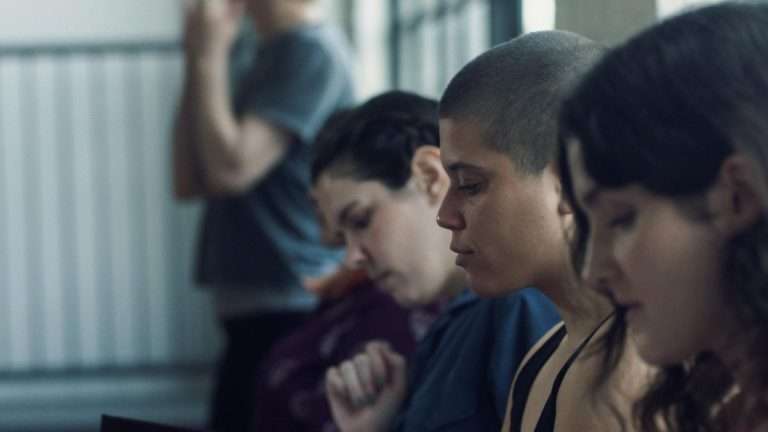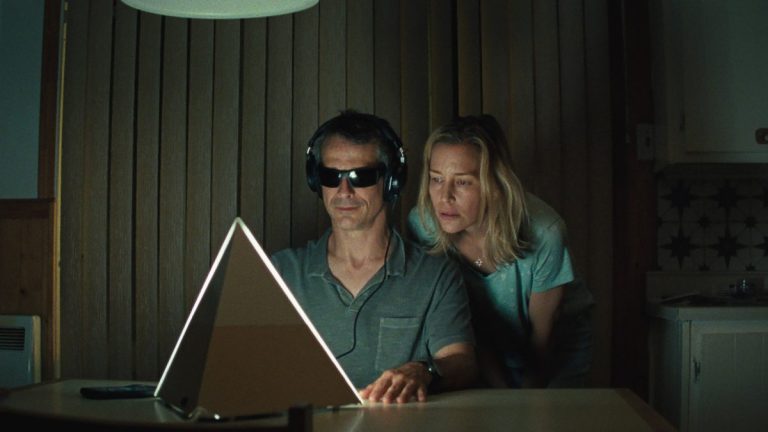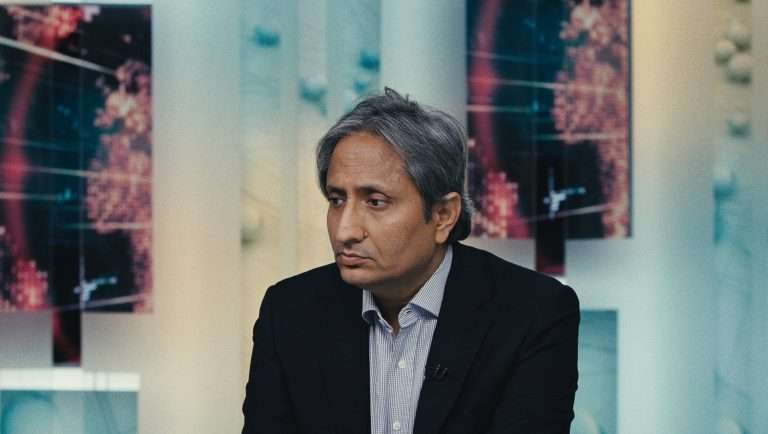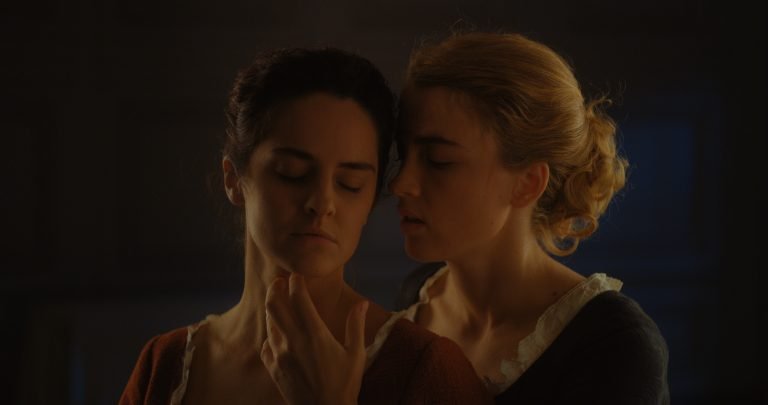Catching Vipin Radhakrishnan at MAMI was a treat, as was watching his not-so-little film “Angammal.” Adapted from Perumal Murugan’s short story “Kodithuni” and set in a quaint village in Tamil Nadu, “Angammal” tells the story of the struggle between a stubborn matriarch who refuses to wear a blouse and her equally stubborn son hellbent on making her do otherwise. All the while, making important commentaries on interpersonal relationships between women and the world.
When I first rushed to meet Vipin amidst the sleep-deprived, caffeine-infused madness that is MAMI, our scheduled interview clashed with the final screening of Shuchi Talati’s “Girls Will Be Girls,” a film I was most eager to watch. One look at me and he knew I was broken up over missing it and decided to push the interview, choosing instead to watch the film with me. I mention this because the tiny incident told me Vipin is observant and perceptive – qualities I find lacking in many male filmmakers, qualities I find essential for someone who has made “Angammal.”
Here is our delayed conversation, in its almost entirety.
Naina Rathi: To begin with, it made me so happy to watch a film made on the subject, simply because we don’t see a lot of older women as protagonists or stories about them, niche cultural markers that are absent from the mainstream. You’ve created this myth and then built a story around that small myth. What was your inspiration behind making the film?
Vipin Radhakrishnan: Okay, the inspiration is obviously the short story written by Perumal Murugan “Kodithuni” which he wrote based on a real-life incident and I found it really humorous. It’s nice to listen to that story, purely as a story itself, apart from the political angle it’s taking. He had written it long back in the late ’90s and I read it in 2020, during the lockdown, and I thought the theme was relevant universally even though he has based it in a rural village in Tamil Nadu.
So, that inspired me: This has to be told as a feature film. And you know, those were the times – even now – of wokeism, people are talking about politics, but most of the stories are based on urban scenarios. Nobody talks about these kinds of characters from villages, from our past and cultural context. So I found it interesting and I thought, “Okay, we’ll give it a try.”
Coming to the mythology part, it was organically written into the screenplay because we went to prep in this village—after visiting all of Tamil Nadu, we found a suitable location 40 km away from Tirunelveli, in a village named Padmaneri. We took a house and stayed there with the villagers for a long time. Slowly, that geography started affecting the screenplay which gradually evolved from the space, the location, the house, everything.
We decided to stick to the base theme and storyline from the book, but everything else was changed after discussing with Perumal Muguran. So the myth came maybe because of the geography and the mountains and the winds of that place where we were shooting. Also, we wanted a texture or tone of storytelling similar to Malgudi Days or RK Narayana’s short stories which is also true of Perumal Murugan’s storytelling – when you read it the first time, it would be a bit light-hearted, simple storytelling but inside, if you look at it again, there might be different layers. So that simplicity we wanted to put.
Also, our generation has grown up listening to myths and stories from grandmas and mothers. And somehow, I feel, this genus of grandmas or mothers, which we were used to when we grew up, will be extinct in one or two generations. So it’s an homage to them. If I look at my grandma, she is similar to Angammal in many ways. She was bold and she had her own ways of loving. Even with and despite all the flaws, we loved her. Then why can’t we love a person for what she is or he is? That was the idea.
Naina Rathi: I agree with what you said, about how you wanted to make a simple story because the conflict of the film is simple. It’s about a woman who doesn’t want to wear a blouse and a son who wants her to. In that small conflict, you managed to say so much about people in rural South India and their expectations of a woman. Even if she is a matriarch and has so much control, she has flaws, she’s not really a nice person – you cannot say that.
But I enjoyed the entire conflict. Can you tell me a little bit about that? How even though she was a matriarch and raised her family, she still had to fight for her rights. I don’t like the term ‘women’s rights’ because we have to keep proving and asking for them, but I liked that she was unabashed. She did not care for anyone else until it came to her son.
Vipin Radhakrishnan: As I said, I have seen these kinds of women – my grandmother has shades of Angammal, my co-writer/dialogue writer, Sudhahar Das’ grandmother has shades of Angammal. Women like this exist in all of India, from that generation which is becoming extinct now. It might be for good but there’s some charm to them because it’s not their problem. The flaws that Angammal has, the reason might be the struggle she had to go through during her childhood. After becoming a widow, she would have to fight all the males.
There is no other way other than to be bold to survive in that village being a widow raising two kids. Gradually, you cannot expect her to be everything. So what she is fighting for, I feel, she is fighting for her individual freedom. She doesn’t know about feminism or anything. She is fighting for her individual rights and what she believes in, she doesn’t want anyone to interfere in her space. And as you said, everybody has flaws even now. It’s like in our movie narratives, we love heroes and heroines but ultimately, in real life, everybody has flaws. So why can’t we love some person accepting their flaws?
Naina Rathi: That’s a nice thing to aim for. Back to a simple question, what does ‘Angammal’ mean?
Vipin Radhakrishnan: Angammal is not a common name, it’s an old name in Tamil which means beauty- grace, and beauty.
Naina Rathi: Very unlike her character.
Vipin Radhakrishnan: I wouldn’t say that.
Naina Rathi: I’m just saying, in a traditional sense, that’s very unlike her.
Vipin Radhakrishnan: I don’t know how to explain it correctly in English, but in Tamil, the name Angammal means that. For me, she represents everything—she is beautiful, she has grace, she has charm.
Naina Rathi: Of course. I looked it up and I wanted to know your perspective on it because she was graceful, she was beautiful and she was charming, like you said. Only not in traditional terms.
Vipin Radhakrishnan: Yeah, only not in traditional terms.
Naina Rathi: Taking from that, you know throughout the film, everyone argues that wearing a blouse is a move towards modernity. People keep telling her, “You have to wear a blouse because it’s modern now” and I found it interesting because her stance was antithetical to that. Her holding on to that tradition was more liberating.
In a sense, we moved from a modern perspective to a more suffocating perspective, if I can say that, from Angammal’s point of view. So, her not wearing a blouse symbolized for me a freedom in her sexuality, a freedom in her ideas and her thoughts, and how she wanted to live her life. Can you tell me a little bit about the conflict in moving away from those traditions that were not so oppressive to begin with? Not a lot of people actually wore blouses in India, it was just a saree that you would wrap around.
Vipin Radhakrishnan: Yes, all around India. Okay, there are two things. First, Angammal is not an easily influenceable person. She is a very practical person because she had to go through a life where she had to struggle to work, raise money, and make her family after her husband died. Maybe because of that, she looks at things as whether she likes it or whether it’s useful.
So, maybe I think wearing a blouse never concerned her. She does not care about what people think or what modernism is. She doesn’t care about that. What she cares about is whether it’s useful or whether she likes it. So, she is as straightforward as that. Another thing, I feel this idea of modernism is a cycle. As you said, in our culture, women never used to wear blouses in most of India. Maybe the British brought it. I don’t know the correct historical time and context, but I think after the British, fashion started to change.
Even in the case of tattoos, culturally, villagers used to have tattoos earlier. Maybe not the modern tattoos but they used to have tattoos and after the ’90s and globalization, these kinds of tattoos went out of fashion. It was something regressive. Now it’s come back in a different form as if modernity brought them back, but we always used to have them. By we, I mean many cultures and many communities. Similarly, I feel she is not influenced by what people say about modernity. She thinks. She has her own brain. (Instead of) right or wrong, she thinks, ‘Is this good for me? Is it comfortable for me? Do I like it?’ She follows that, that’s all.
Naina Rathi: That’s completely fair. A lot of times, women are not even allowed that much. In stories like these, they either become the torch-bearing hero or someone who’s on the opposite end of the spectrum. I like that she only cared about how it affected her. There are other elements in the film that I also enjoyed – you openly talked about breastfeeding and how it affects the female body, and you showed an older woman, her quiet desires, and her interest in this other man – which were seamlessly woven into the narrative.
It’s part of who she is. However, the man never responds to her advances properly, he’s shy but interested in her and has accepted who she is. Yet he cannot take that step. I wanted to ask you, is it that when she’s wearing a blouse, she’s no longer a dominant figure? Until then he’s very shy and the moment she wears a blouse, he starts approaching her openly. On the bus, remember, when he follows her?
Vipin Radhakrishnan: Okay, I feel there might be multiple reasons. First of all, clearly, we show he’s a shy guy, and more than shyness, it’s a village, people will talk, so it’s a volatile issue – a married man and a woman having an affair. We think that everything happens only in cities, but the truth is, if you go to any Indian village, these kinds of things happen. But this guy is a bit shy, he’s not an alpha guy. He’s concerned about what people will say. But you can, from his reaction, know that there was something between them in the past and he still has that.
Then, even in the Kesari scene, when he gets a small moment, his reaction is positive. You know he likes her. Second thing, after he finds her alone somewhere – there are no villagers, nobody there. So that might be one reason he’s a bit more confident. Plus, inside the bus, she’s looking not as confident or aggressive, and not dominant in her body language. In her looks, she feels a bit down and maybe that would have given him much more confidence to approach, you know, which is natural – when you see some dominant guy, you might be intimidated, you know.
So maybe that intimidation was no longer there. It’s a combination of all these factors. Including there was nobody there to look at them. Another thing to add, we men-we’ve all grown up like that. There’s a bit of hypocrisy in all of us which is part of our culture, which is changing for good. But I think it used to be there, you know.
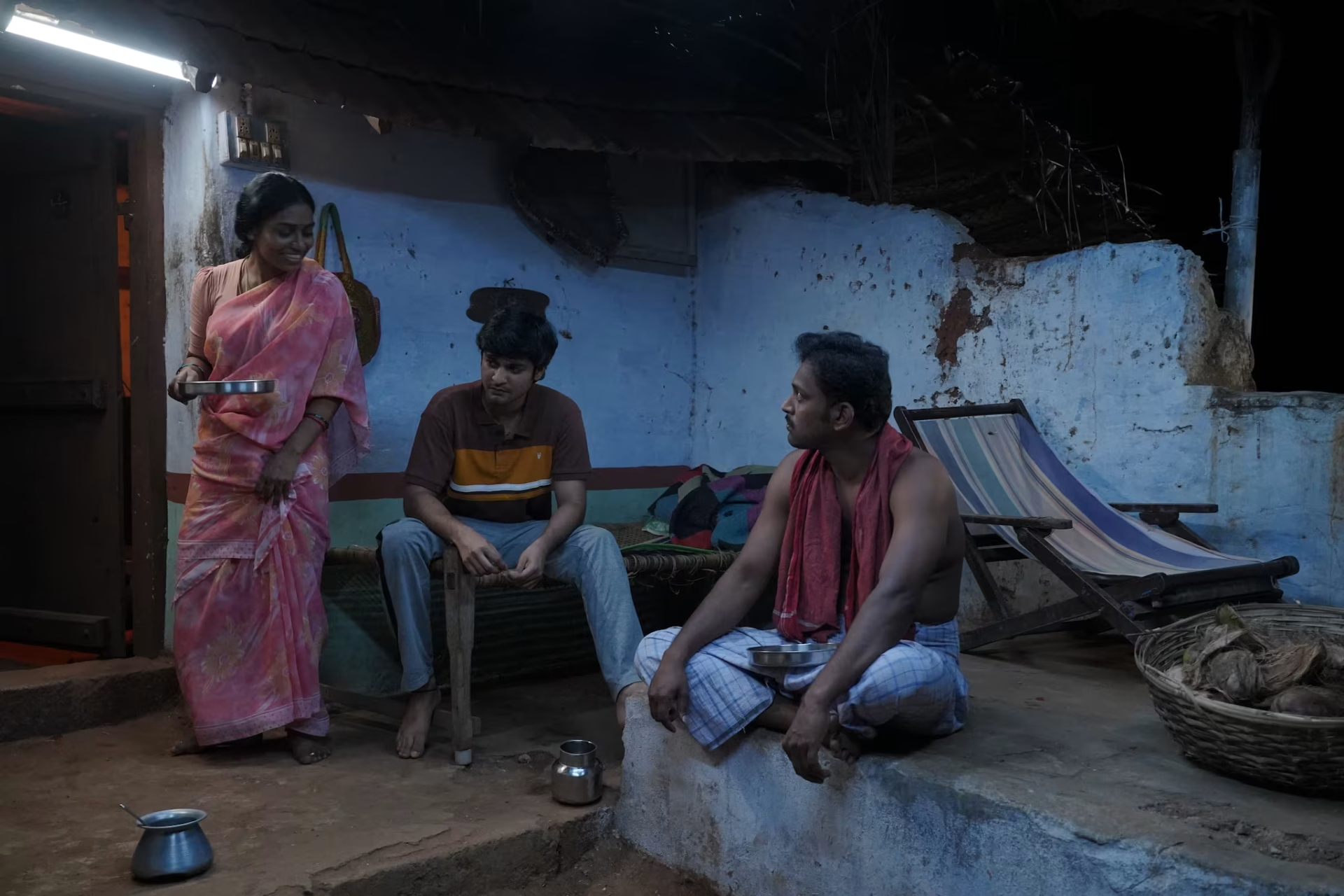
Naina Rathi: It still is there. It’s part of humanity. We’re hypocrites by nature. Her relationship with her sons is strained, but she cares about the son enough to give in to what he wants. It was interesting to watch that dynamic—they never ask or tell her things directly, they always go through a third person. She keeps asking, “Why are you not talking to me directly?” This happens to women a lot and you put it in such a nice way in the film, but I’ve been trying to find out why this happens. We’re not told things directly, it’s just understood that we’re supposed to be in a certain way. I don’t know if there’s a question here.
Vipin Radhakrishnan: Yeah, I’m also thinking about it now. Which is true. I connect to what you’re telling me. Maybe because this is how it was when I wrote, it naturally came like that. You know, because we are used to family and everything.
Naina Rathi: Definitely. You see these things and they reflect in your work.
Vipin Radhakrishnan: Even if you take the opposite thing, like a dad telling a daughter, most of the time it’s not a direct statement.
Naina Rathi: They go through the mother, they tell the mother.
Vipin Radhakrishnan: They tell the mother, yes.
Naina Rathi: If things were different- if it was a man in Angammal’s place and his attire was not appropriate, do you think it would have been the same? Do you think there would have been an issue at all?
Vipin Radhakrishnan: If you are thinking about the shirtless thing, it won’t be a big problem. Even now people walk around shirtless because it’s too hot there.
Naina Rathi: The man, the younger son, was more concerned with how his mother looked to his in-laws, but his fiancée did not have any problems with her. She’d heard all these stories about Angammal but then saw her in that blouse looking so demure, so submissive. There was an unsaid sisterhood for she was more understanding of the woman than her own son. We see it in their interaction and then you leave it because it doesn’t need to be explained further.
Vipin Radhakrishnan: I think it was natural for her character because she is the one who knows the entire story. From the start itself, she knew that her boyfriend was insecure. But she thought the insecurity was mainly because he’s from a village and a small, poor family. But in the end, she realizes, that there is a bigger insecurity (at play here), but she was okay. Also, as you said, the stories she heard about Angammal are completely different from when she sees her – she’s very shy, so she might have empathized with her.
Naina Rathi: My favorite part of the film is the ending because it comes to a full circle. She gives in to her son’s wants, thinking it’s only a one-time thing but then she realizes that she will have to keep doing it over and over again. Once is not enough. So, can you tell me a little bit about that? You know, once you give in that’s like giving in forever. When men ask these things of women, it’s not a transaction that’s only one time. They keep asking more and I like that in the end, when she realized that this is going to keep happening, she just left. Without making it preachy, how did you manage to get there?
Vipin Radhakrishnan: The ending was the most challenging because, in the original story, the character itself is different. She’s naive, more subdued and it’s a dark ending in the original story. We changed the characterization and how we narrated it, adding the mythology and other elements. When you look at the ending, I couldn’t take any sides there and I cannot give a definite answer also. It was challenging, but somehow, because this mythology came in, we organically ended up reaching this ending. It’s not like it was planned, but gradually, from this place, the mythology came and when the screenplay progressed, we reached an end where it closed naturally. And another thing, I feel that the story actually ends after the conversation between the son and mother, after the Uchichimala winds come, they sit there and she understands: This won’t change.
Naina Rathi: This won’t change.
Vipin Radhakrishnan: Then it’s a tail end, where she’s giving in for her son- then there is no ego because she completely understands him. She thinks: “One time, I will hear it for him then I will do whatever I want.”. So, it organically reached there, nothing was planned and I’m happy. It might not happen every time. Another thing, many people have problems with the ending. Not many- few people came to me and said they didn’t understand it. It’s an open ending and maybe those are people who aren’t happy with open endings. Nothing can be done about it.
Naina Rathi: I genuinely thought it was a perfect closure because you talk about it in the beginning- how when evil visits the village, the winds take it away. In her version, because she could not escape the evil, she thought, “I will take myself out of here, I will go away.” It felt very cathartic to me because she was deeply connected with those stories and through those stories with her mother, her grandmother, and her best friend—the most important people in her life. When she lost them, the next important persons were her children, and when they could not understand her, she was like, “I have to see myself out”.
Vipin Radhakrishnan: Also, why does a woman- she can have her own life, separate from her sons, you can look at it that way also?
Naina Rathi: Yes. And it worked because her husband was not there. If the husband was there, the whole thing would be different.
Vipin Radhakrishnan: It’s a different thing, yes. And they don’t need her anymore. The way they were, they might be sad and all but apart from that, technically, they didn’t need her.
Naina Rathi: That’s interesting to hear. For the end, I want to ask what were some of your inspirations while making this film – in writing, in terms of films, in terms of filmmaking?
Vipin Radhakrishnan: I would say… I don’t know how to say it because the inspiration was Malgudi Days, in a way although I haven’t watched Malgudi Days in 25 years. I only remember watching Malgudi Days. In fact, I might not even like it if I watch it now. But I remember the feeling of watching it during the ‘90s when I was a kid. So, I tried to connect with that feeling and make a narrative out of it although I didn’t revisit it. Same with RK Narayan’s short stories. I didn’t read them again, but I know the feeling I get while reading them. Then, of course, Perumal Murugan’s writing has its own simplicity – very real, very rooted, and his stories come from those spaces. So, Perumal Murugan, RK Narayanan, and Malgudi Days were the inspiration for me.
Also, maybe to a certain extent, what you call art house- not art house, middlestream Hindi cinema. You know, Shyam Benegal films? When we had to cast a character, the first thing was: Whom will we cast for Angammal? Wish we had someone like Shabana Azmi or Smita Patil. Maybe because of them, Shyam Benegal’s movies were an inspiration. They would have been perfect for this role in their prime, so we were looking for someone like that. We didn’t find anyone like that in the Tamil Industry, but luckily, with Natchathiram Nagargiradhu, we found Geeta Kailasam. We liked her performance, she’s a natural and has a great screen presence.
One more thing, we were really happy that in the second screening, Shabana Azmi came to watch the movie. She loved it, so it was really such a nice experience (he gushes.) We thought of her while casting two years back and she came to watch the movie naturally- it’s not like we tried to get her and watch the movie. It felt so good.
Naina Rathi: I’m happy that happened. One last thing, you said that you want this film to have a theatrical release, right? So do we have a date? Is it going to happen anytime soon?
Vipin Radhakrishnan: This movie has been made with passion, by a group of strong, passionate people. It took us two years, but because we could make this movie, we are confident we can bring it to theatres too. I cannot say the dates but by next year – beginning or mid – it should be in theatres. Not only Tamil Nadu theatres, we want it to be released all over India.
The filmmaker was sure (afraid) that people would classify Angammal as a festival film and not think it commercially viable. However, unlike typical ‘festival’ films, Angammal was not made on an indie budget so as to not compromise on any technical qualities.
In all its sincere simplicity, “Angammal” carefully holds nostalgic intents within its dear folds. The filmmaker’s endearment for Angammal is apparent. It’s enjoyable to root for a protagonist as she chips away at your conditioning for one doesn’t want a woman who speaks loudly, who drives a bike, who has her own business that she’s running, who refuses to dress up all pretty and modest like people want her to.
At no point do Vipin and his film preach. Angammal is not a heroic heroine, she’s not a perfect, saintly woman because nobody, man or woman, is like that. The film poses many simple yet essential questions without further explanation, imploring the audiences to think over and find answers for themselves. I enjoy films that make me think, provide me with enough problems to mull over, allow me the freedom of exploration, and hold enough within them for me to partake in and take something back home with me.


